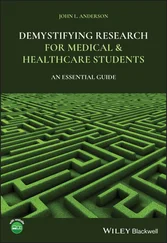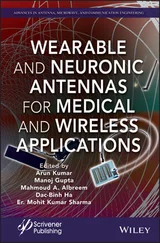Alvaro Meseguer - Fundamentals of Numerical Mathematics for Physicists and Engineers
Здесь есть возможность читать онлайн «Alvaro Meseguer - Fundamentals of Numerical Mathematics for Physicists and Engineers» — ознакомительный отрывок электронной книги совершенно бесплатно, а после прочтения отрывка купить полную версию. В некоторых случаях можно слушать аудио, скачать через торрент в формате fb2 и присутствует краткое содержание. Жанр: unrecognised, на английском языке. Описание произведения, (предисловие) а так же отзывы посетителей доступны на портале библиотеки ЛибКат.
- Название:Fundamentals of Numerical Mathematics for Physicists and Engineers
- Автор:
- Жанр:
- Год:неизвестен
- ISBN:нет данных
- Рейтинг книги:5 / 5. Голосов: 1
-
Избранное:Добавить в избранное
- Отзывы:
-
Ваша оценка:
Fundamentals of Numerical Mathematics for Physicists and Engineers: краткое содержание, описание и аннотация
Предлагаем к чтению аннотацию, описание, краткое содержание или предисловие (зависит от того, что написал сам автор книги «Fundamentals of Numerical Mathematics for Physicists and Engineers»). Если вы не нашли необходимую информацию о книге — напишите в комментариях, мы постараемся отыскать её.
Fundamentals of Numerical Mathematics for Physicists and
Engineers
Provides a modern perspective of numerical mathematics by introducing top-notch techniques currently used by numerical analysts Contains two parts, each of which has been designed as a one-semester course Includes computational practicals in Matlab (with solutions) at the end of each section for the instructor to monitor the student's progress through potential exams or short projects Contains problem and exercise sets (also with solutions) at the end of each section is an excellent book for advanced undergraduate or graduate students in physics, mathematics, or engineering. It will also benefit students in other scientific fields in which numerical methods may be required such as chemistry or biology.
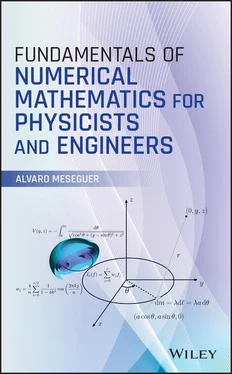
 that is continuous within the interval
that is continuous within the interval  . Mathematically, the main goal of exact root‐finding of
. Mathematically, the main goal of exact root‐finding of  in
in  is as follows:
is as follows: such that
such that  .
. cannot be exactly satisfied, in general. Therefore, we need to reformulate our problem:
cannot be exactly satisfied, in general. Therefore, we need to reformulate our problem: , find
, find  such that
such that  for some
for some  .
. , usually termed as tolerance , whose meaning is outlined in the plot on the right. Since the root condition
, usually termed as tolerance , whose meaning is outlined in the plot on the right. Since the root condition  cannot be satisfied exactly, we must provide an interval containing the root
cannot be satisfied exactly, we must provide an interval containing the root  . In the figure on the right, the root
. In the figure on the right, the root  lies within the interval
lies within the interval  .
.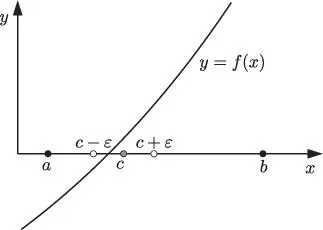
 is a continuous function within the interval
is a continuous function within the interval  within which the function has a single root
within which the function has a single root  . Since the function is continuous,
. Since the function is continuous,  . First, we define
. First, we define  ,
,  , and
, and  as the starting interval whose midpoint is
as the starting interval whose midpoint is  . The main goal of the bisection method consists in identifying that half of
. The main goal of the bisection method consists in identifying that half of  in which the change of sign of
in which the change of sign of  actually takes place. Use the simple rules:
actually takes place. Use the simple rules:
 and
and  .
.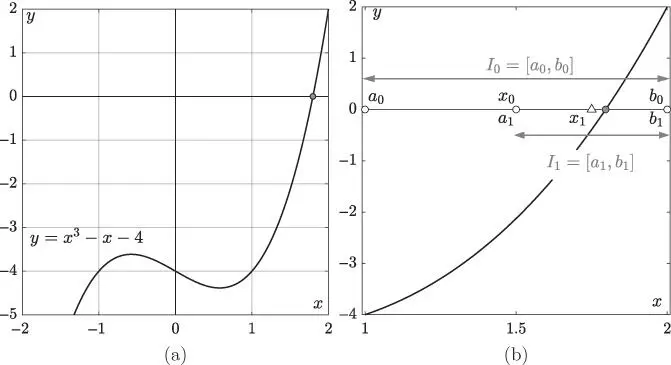
 reveals a change of sign within the interval
reveals a change of sign within the interval  (the root has been depicted with a gray bullet). (b) We start the bisection considering the initial interval
(the root has been depicted with a gray bullet). (b) We start the bisection considering the initial interval  . The bisection rule provides the new halved interval
. The bisection rule provides the new halved interval  .
. already studied in Eq. ( 1.2). As shown in Figure 1.1a, this polynomial takes values of opposite sign,
already studied in Eq. ( 1.2). As shown in Figure 1.1a, this polynomial takes values of opposite sign,  and
and  , at the endpoints of the interval
, at the endpoints of the interval  whose midpoint is
whose midpoint is  . Since
. Since  , the new (halved) interval provided by the bisection rules is
, the new (halved) interval provided by the bisection rules is  . The midpoint
. The midpoint  of
of  (white triangle in Figure 1.1b) provides a new estimation of the root of the polynomial. We could resume the process by checking whether
(white triangle in Figure 1.1b) provides a new estimation of the root of the polynomial. We could resume the process by checking whether  or
or  in order to obtain the new interval
in order to obtain the new interval  containing the root and so on. After
containing the root and so on. After  bisections we have determined the interval
bisections we have determined the interval  with midpoint
with midpoint  . In general, the interval
. In general, the interval  will be obtained by applying the same rules to the previous interval
will be obtained by applying the same rules to the previous interval  :
:
